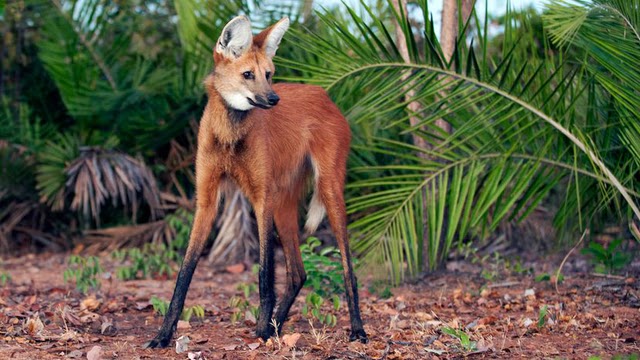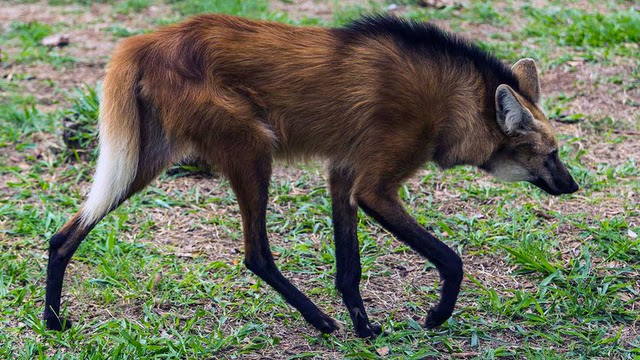Quck answer
The maned wolf, despite its name, is not a wolf at all. It is a unique species, the only member of its genus, and can be found in South America. While it may look like a fox on stilts due to its long legs, it is not closely related to foxes either. Maned wolves are omnivorous and primarily eat small mammals, birds, and fruits. They are also known for their distinctive vocalizations, which sound like a high-pitched bark. Unfortunately, maned wolves are classified as a near-threatened species due to habitat loss and fragmentation. Conservation efforts are underway to protect these beautiful and fascinating animals.
Wild Animals

The maned wolf (Chrysocyon brachyurus) resembles a red fox, but with much longer legs. Dorit Bar-Zakay/Getty Images
Humans have had a close relationship with domestic dogs for thousands of years, leading to a stereotypical image of what wild canids should look like. However, the maned wolf (Chrysocyon brachyurus) defies these preconceptions. Found in South America, it is the largest canid on the continent, standing almost 3.2 feet (1 meter) tall at the shoulder with extremely long and slender legs.
The maned wolf prefers open spaces, such as grasslands and savannahs, but can also be found in swampy areas, along riverways, and at the edges of shrub-lined forests. Adults have reddish-auburn coats, though some may be black-furred due to a genetic mutation called melanism.
Despite its resemblance to a red fox, the maned wolf is not actually a fox or a wolf. Its closest relative is the bush dog, a small mammal found in South America. The maned wolf was also closely related to the now-extinct Falkland Island wolf, which was wiped out by sheep farmers in the 19th century.

The maned wolf is found in open and semi-open habitats, especially grasslands with scattered bushes and trees, and is the largest canid of South America.
Jonathan Wilkins/Wikimedia/(CC BY-SA 3.0)
The maned wolf’s unique legs are not just for navigating tall grasses, but are also tied to its diet. Unlike other canids that weigh over 33 pounds (15 kilograms) and eat meat exclusively, the maned wolf also consumes a significant amount of fruit. In fact, fruits and vegetables make up 60 percent of its diet, according to a study of 328 poop samples.
Maned wolves have a varied diet which includes tubers, bulbs, sugar cane, and a green fruit called the “wolf apple”. They also swallow a large number of seeds which they disperse through their droppings. The wolves are able to reach fruits that are suspended up to 66.9 inches above the ground due to their elongated legs. Despite being omnivorous, maned wolves are predators and will eat insects, reptiles, birds, rabbits, and armadillos. The maned wolf’s versatile diet may have contributed to their survival while the dire wolf, a carnivorous predator that specialized in hunting large prey, became extinct as its food source decreased. Maned wolf pups are mostly raised by their mothers, but sometimes the fathers help out too. Adults are monogamous and share a large territory but travel alone for most of the year. Breeding season lasts from March to June, and the males may help with pup-rearing. Maned wolves communicate through scents, growls, and a distinctive roar-bark. Their urine has a strong marijuana-like odor. The wolves’ mane is made up of long black hairs that stand upright when the animal is threatened, making it look bigger. Maned wolves are a protected species with only 23,000 adult wolves left in the wild due to habitat loss.
FAQ
1. What is a maned wolf?
A maned wolf is a large, solitary canid species native to South America. Despite its name, it is not closely related to wolves and is the only species in its genus, Chrysocyon. The maned wolf is characterized by its long, slender legs and distinctive mane of fur that surrounds its neck and shoulders.
2. What do maned wolves eat?
Maned wolves are omnivores and their diet consists of a variety of foods including small mammals, birds, insects, and fruits. They are also known to consume termites and other insects, which make up a significant portion of their diet.
3. How tall can maned wolves grow?
Maned wolves are known for their long legs, which can measure up to 30 inches in height. They can grow to be around 3 feet tall at the shoulder and can weigh up to 50 pounds.
4. Where do maned wolves live?
Maned wolves are found in open grasslands, savannas, and dry forests throughout South America. They are most commonly found in Brazil, but can also be found in other countries such as Argentina, Paraguay, and Bolivia.
5. Are maned wolves endangered?
Maned wolves are considered a near-threatened species by the International Union for Conservation of Nature (IUCN). Their populations have declined due to habitat loss and fragmentation, as well as hunting and trapping. Conservation efforts are underway to protect and increase their populations.
6. Do maned wolves make good pets?
No, maned wolves do not make good pets. They are wild animals and require specialized care and a specific diet. It is also illegal to keep them as pets in many countries, including the United States.
7. Are maned wolves dangerous to humans?
No, maned wolves are not dangerous to humans. They are shy and generally avoid human contact. In the rare event that a maned wolf feels threatened, it may bark or growl, but it is unlikely to attack.





Leave a Reply